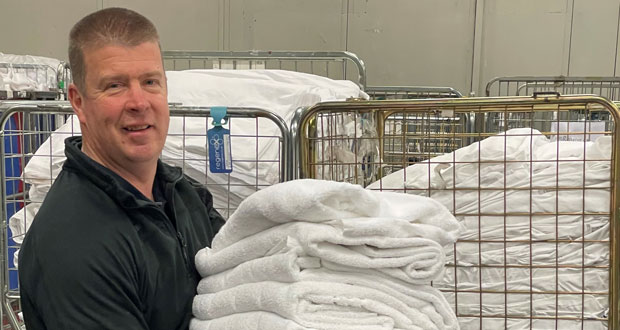Specialist commercial linen cleaning company, Regenex, has reached its target milestone of successfully returning 1,000 tonnes of linen back to its customers — saving 3K tonnes of carbon in the process.
Founded in 2017, the West Yorkshire-based company has continued to grow following the interruption of the pandemic and has since rescued 1,000 tonnes of the UK’s dirtiest linen which would have otherwise been condemned to landfill or ragged.
Regenex’s patented multi-bath cleaning process is helping its clients improve their green credentials while also saving thousands of pounds, with customers no longer needing to purchase top-up stock as often. Having received 1400 tonnes of dirty linen to date, the stain removal treatment has over a 70 per cent success ratio, with the remaining 400 tonnes of material rejected due to rips and holes or as a result of residual staining — the remaining linen is then sold on as premium rag to extend its life cycle just that bit further.
Commenting on the milestone achievement, Paul Hamilton, Technical Director, said: “Here at Regenex, we’re incredibly proud of this achievement and would like to thank our loyal client base. While the bulk of our business is with hospitality linen providers, we have also worked with NHS laundries, independent B&B chains as well as smaller, high-end industrial laundry providers. As of November 2023, Regenex has achieved over 50 tonnes of linen returned to three of its clients, with another client set to receive 100 tonnes successfully returned within the coming months.
“Since the formation of Regenex, the linen returned to our clients has predominantly been white hospitality and healthcare linen but has also included workwear and some over-dyeing and topping up of table linen.”
On average, for every tonne of linen processed by Regenex saves three tonnes of carbon and five million litres of water — compared to a staggering 3K tonnes of carbon and five billion litres of water that would have otherwise been used if the 1,000 tonnes of linen been replaced with brand new polycotton.
Hamilton continued: “As we continue to extend the life of our customers’ linen, we’re delighted to have reached such a milestone figure already, one which further proves our commitment to reducing textile waste, one tonne at a time.
“With over 80 per cent of a textile’s carbon footprint resulting from its initial manufacture and transportation, the least we can do is attempt to use it for as long as possible — before considering the most ethical method of disposing or recycling it.”





